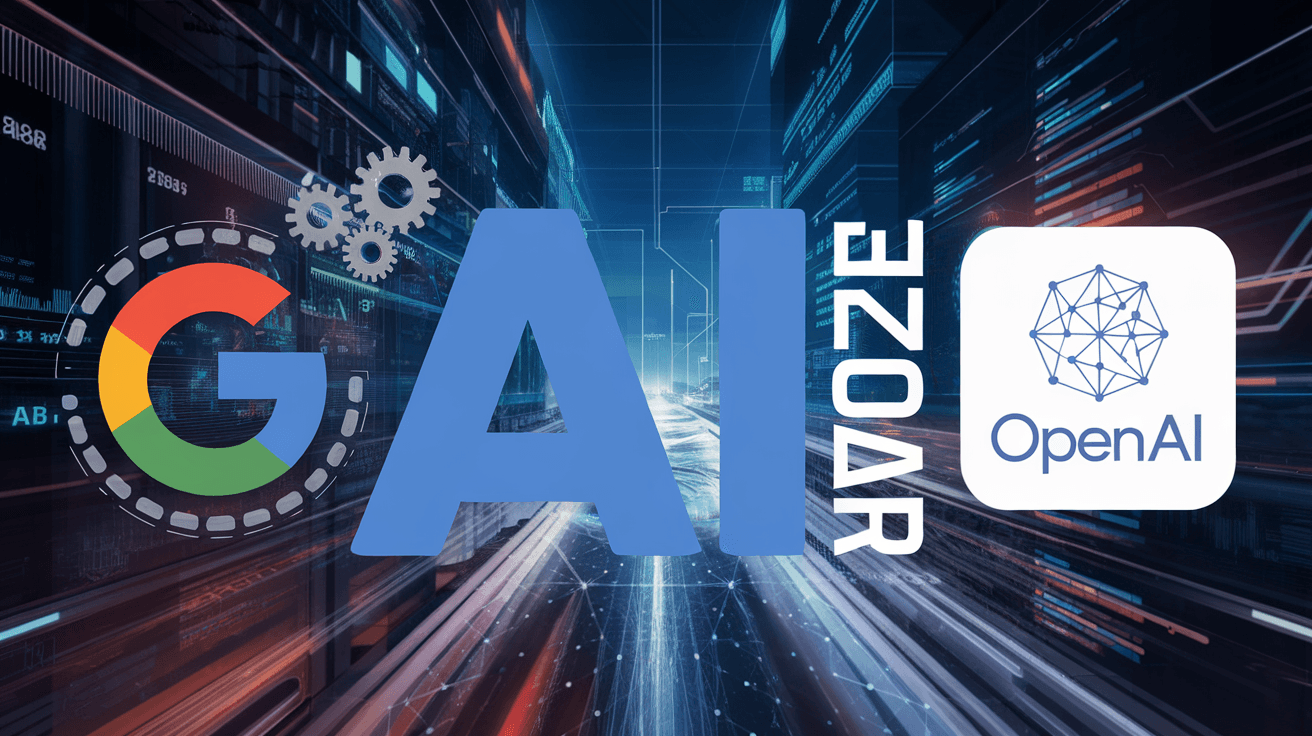AI in 2025: Google Gemini vs OpenAI Innovations

Artificial Intelligence in 2025: Transformative Advancements
In 2025, artificial intelligence continues to reshape industries through groundbreaking advancements. Key innovations like Google Gemini 2.0 Pro and OpenAI's Deep Research Model are at the forefront, illustrating a dynamic competitive landscape. These models cater to the rising demand for AI applications across sectors, enhancing tasks from multimodal processing to complex problem-solving. As the race between AI giants intensifies, these developments underscore a new era in AI integration and capability expansion.
Background and Context
The historical evolution of AI models showcases a journey from rudimentary rules-based systems in the 1950s to sophisticated models that leverage multimodal capabilities in 2025. Initially, early AI's logic-driven algorithms, typified by expert systems like MYCIN, offered limited scope due to their deterministic nature. However, the introduction of machine learning in the 2000s enabled data-driven insights, while deep learning provided the architecture necessary for recognizing complex patterns across various domains, including image and speech recognition [Source: Lantern Studios].
By 2025, AI transformed through advancements emphasizing multimodal integration, facilitating data processing from text, images, videos, and real-time data sources. AI systems exhibit unprecedented functionality, seamlessly executing tasks across diverse sectors—healthcare systems analyze patient records and MRI images simultaneously, while educational platforms adapt to users through engaging multimedia content [Source: Vocal Media]. This landscape has set the stage for innovative models like Google Gemini 2.0 Pro, highlighting AI's evolution into a critical component of modern technology across industries.
Google Gemini 2.0 Pro
Google Gemini 2.0 Pro represents a significant advancement in AI technology, characterized by its massively scalable context window and superior coding performance. A standout feature of Gemini is its multimodal capabilities, allowing it to process a combination of text, images, and audio dynamically. This flexibility enhances user interaction, enabling developers to build more engaging applications that can use different types of input simultaneously. The integration with Google Search provides real-time data retrieval, which is crucial for maintaining up-to-date information in applications. Furthermore, Gemini's architecture allows for native image processing, text-to-speech functionality, and seamless integration with tools like Google Maps and Lens, making it versatile for various use cases in software development and research tasks [Source: Google Blog].
In coding performance, Gemini distinguishes itself with a remarkable 2 million token context window, enabling the analysis of extensive datasets such as lengthy documents or complex programming tasks. Its integration with Python facilitates native code execution, enhancing automated workflows. Gemini 2.0 Pro shows tremendous performance in coding benchmarks as well, capable of generating sophisticated software solutions and mathematical proofs with clarity in the reasoning process [Source: Marketing Trending]. This positions Gemini effectively within the competitive landscape, offering tools that significantly augment AI research capabilities and improve the overall integration of advanced analytics and data handling tasks.
OpenAI’s Deep Research Model
OpenAI's Deep Research Model is engineered for autonomous research, equipped with capabilities that allow it to conduct detailed investigations independently. At its core, the model utilizes the OpenAI o3 model, optimized for web browsing and data analysis, enabling it to autonomously gather data online, interpret images, and parse PDFs, synthesizing findings into structured reports [Source: PYMNTS]. The Deep Research Model excels in processing diverse information formats, integrating insights into comprehensive analyses replete with sourced citations, thereby drastically diminishing dependence on conventional manual research methods [Source: Dirox].
The model has exhibited impressive performance metrics, achieving 26.6% accuracy on the challenging Humanity's Last Exam and demonstrating state-of-the-art results on benchmarks like the GAIA for real-world queries requiring complex, multi-modal reasoning [Source: Open Tools]. This positions the model as an invaluable asset in industries such as finance, engineering, and policy, where it can produce extensive research analyst-level reports in a fraction of the time previously required [Source: Vanderbilt University].
AI Race: Google vs OpenAI
The competitive landscape between Google and OpenAI intensifies as models like Gemini 2.0 and OpenAI's O3 emerge as critical players. Gemini 2.0 boasts a latency of 200ms, outperforming OpenAI GPT-4’s 250ms, facilitated by optimized algorithms. This speed advantage is crucial for dynamic application environments where responsiveness can dictate usability [Source: Adyog Blog]. In terms of accuracy, Gemini achieves 95%, slightly higher than O3’s benchmarks, which excel in reasoning tasks but require considerable computational resources, with costs upwards of $20 for low-compute tasks [Source: Adyog Blog].
Accessibility remains a pivotal factor; Gemini 2.0’s API charges $0.015 per 1,000 tokens, underscoring its competitive pricing as compared to OpenAI's $0.020. Gemini is seamlessly integrated into Google Workspace, enhancing user productivity through tools like Docs and Sheets [Source: Observer]. Conversely, OpenAI's O3, while offering broad functionality across platforms like WhatsApp, faces challenges due to its resource-intensive nature, limiting its adoption among smaller businesses [Source: Composio].
The divergent market focus highlights Gemini 2.0’s alignment with compliance-heavy industries like finance and healthcare, providing safety customization, alongside Microsoft’s ecosystem leverage. In contrast, O3 is tailored for researchers prioritizing cognitive tasks over speed [Source: Jurnals.net].
Trends Shaping the Future of AI
Emerging trends in AI signal a transformative trajectory, notably through the rise of agentic AI and multimodal integration. Agentic AI, or autonomous systems capable of executing collaborative tasks, is becoming increasingly prevalent across sectors. For instance, deployments in cybersecurity illustrate its capability to manage threats independently, with a notable third of IT leaders already utilizing these technologies [Source: RightHand AI]. This advancement not only enhances operational efficiency but also raises complex ethical concerns regarding bias and safety, particularly in sensitive areas like healthcare [Source: Digital Defynd].
Simultaneously, multimodal integration, which merges various data types such as text, audio, and visual content, is reshaping decision-making processes. In finance, for example, this capability facilitates nuanced market sentiment analysis by integrating textual data with facial recognition technology [Source: Google Cloud]. Yet, as AI systems become more integrated, they are not without risks; such advancements present opportunities for adversarial attacks and unauthorized deployment, creating vulnerabilities that demand immediate attention [Source: CIO].
Navigating these trends necessitates a robust governance framework that prioritizes ethical and proactive regulatory measures, ensuring AI advancements do not outpace societal values. The interplay between innovation and ethical considerations will likely dictate the future landscape of AI technologies, making it essential for industries to engage in responsible AI development and implementation [Source: MIT Sloan Review].
Challenges and Opportunities
The exploration of AI technologies today highlights significant barriers, including issues of trust, performance, and ethical considerations. Trust remains a pivotal concern, as modern AI systems often produce unreliable outputs that users find challenging to interpret, leading to skepticism in high-stakes applications like healthcare and finance [Source: Simplilearn]. Moreover, inherent biases within training data exacerbate the amplification of discrimination across various sectors, notably in recruitment and law enforcement, where unjust outcomes can have profound consequences [Source: Harvard Business Review].
Current performance limitations compound these issues, particularly regarding energy consumption and computational demands of large language models. The environmental impact raises pressing sustainability questions, urging a shift towards more energy-efficient architectures [Source: Georgetown University]. Addressing these complexities involves fostering human-AI collaboration and enhancing governance frameworks to ensure ethical deployment.
Conversely, substantial opportunities emerge through transparency and bias mitigation. Developing structured documentation frameworks can enhance accountability, while algorithmic fairness tools facilitate equitable outcomes in AI deployments. Transparency can also serve as a competitive advantage, particularly in sectors like healthcare, where explainable AI functionalities promote user trust [Source: AWS]. By prioritizing these strategies, stakeholders can harness the innovation potential of AI while addressing its inherent risks.
Conclusions
In conclusion, 2025 marks a significant year for AI, driven by innovations such as Google Gemini 2.0 Pro and OpenAI's Deep Research Model. These advancements demonstrate AI's growing perceptive capacity and ability to integrate seamlessly across various applications. As competition between major players heats up, strategic considerations around ethics, security, and operational efficiency remain crucial. Moving forward, businesses and developers must adapt to leverage these powerful AI tools while addressing emerging challenges and opportunities for growth. The landscape of AI is poised for even greater transformation and influence.
Sources

Josh Pocock
josh@executivestride.comJosh Pocock is a serial entrepreneur and visionary founder of ExecutiveStride.com and StrideAgents.com. Beginning his career in door-to-door sales, Josh built over a decade of direct sales and marketing experience before pioneering the integration of AI technology to transform business operations.
Josh helps companies "Accelerate Their Stride" through comprehensive AI solutions, marketing automation, lead gen, & sales optimization. He offers AI DWY (done-with-you) services, educational products, coaching, & exclusive masterminds. With over 5 years of expertise in GoHighLevel, Josh and his team have built custom solutions for multi-million dollar businesses across diverse industries. He has hundreds of YouTube videos sharing his expertise on AI & business growth.
Josh enables businesses to seamlessly integrate AI solutions like AI call centers, employees, & appointment setters, revolutionizing how companies operate & scale with StrideAgents.com.